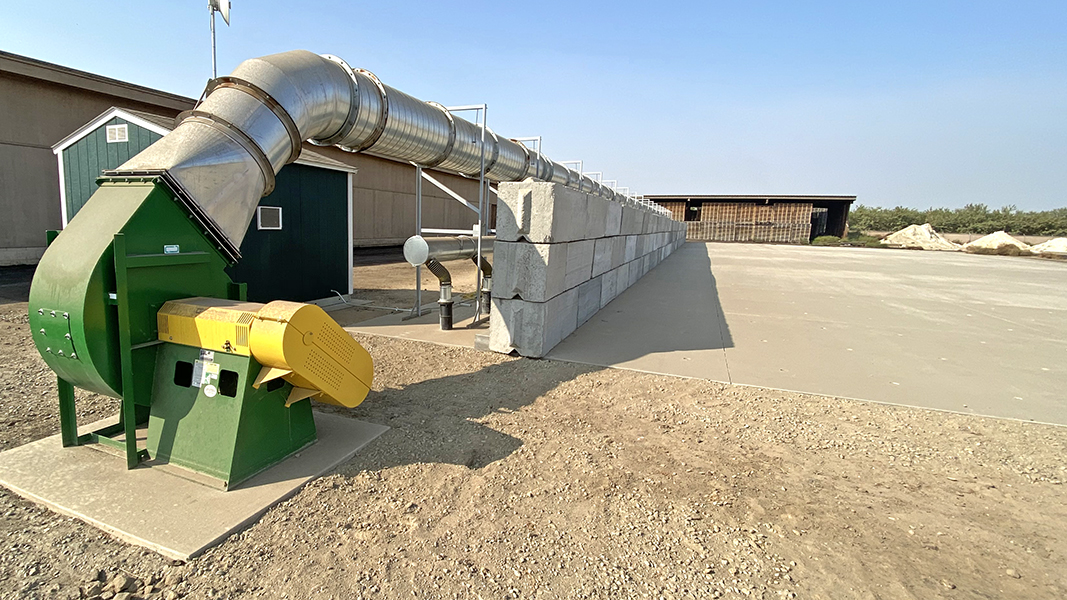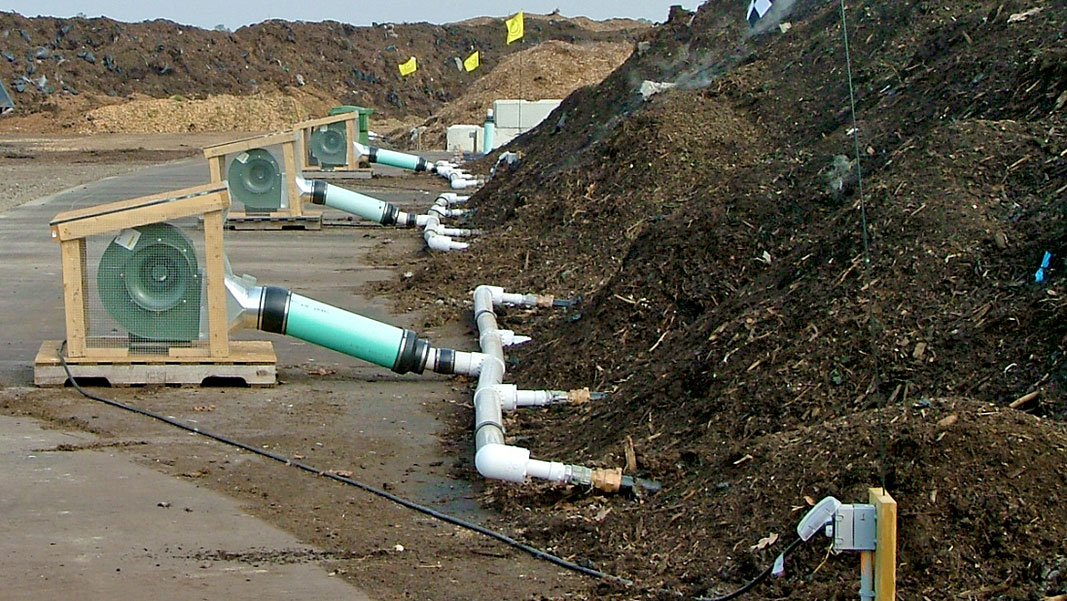Top: Example of a centralized fan system. Photo courtesy of ECS
Baraka Poulin
Composting, an aerobic process, relies on microbial bio-oxidation, combining complex organic molecules with oxygen to form carbon dioxide (CO2), water and heat. The first step in designing an aeration system requires understanding how much total oxygen is needed. The reaction in Figure 1 shows the simplified process.
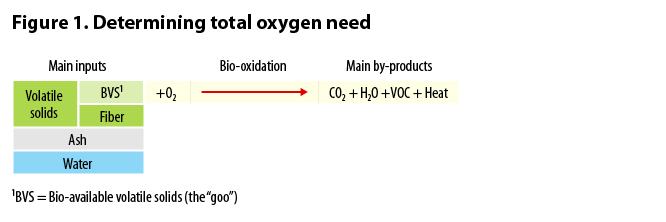
Some systems, such as unaerated windrows, use passive infiltration to provide this oxygen via semi-anoxic conditions. However, this approach delivers minimal oxygen to the material, severely limiting the rate at which bio-oxidation can occur. Much like a fire, blowing more air on the compost reaction can increase the reaction rate if there is sufficient fuel. It is common to see forced aeration systems achieve stability improvements (measured in change in Solvita or CO2 respiration) in 10 to 15 days, versus 90 days or more in an unaerated system.
Aerobic compost aeration design must consider both metabolic air (how much air is required by the biology) and cooling air (how much air is needed to prevent a pile from overheating). While this varies by application, the cooling air requirements almost always exceed the metabolic requirements and drive the design. This is noted in peer reviewed journals, field measurements, and Engineered Compost Systems’ (ECS) in-house aeration demand test system. The CO2 parts per million (PPM) curve (Figure 2) is typical for composting organic feedstocks, where CO2 (an indicator of biological activity) shows a tremendous initial spike as microbes consume the readily available goo. This spike in exothermic activity heats up the pile. As organic matter is converted to CO2, the reaction rate begins to slow.
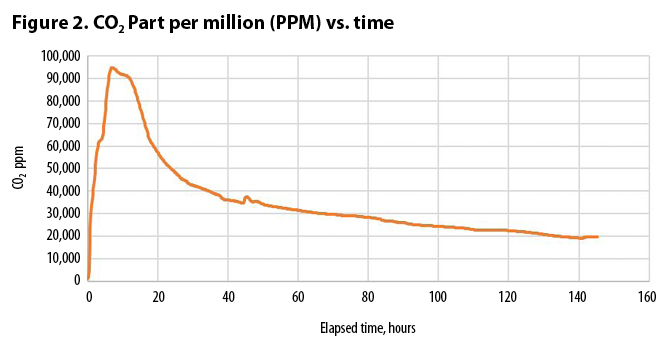 Centralized Versus Dedicated Compost Fans
Centralized Versus Dedicated Compost Fans
The total airflow required is a function of the oxygen (O2) demand over the total retention time of the composting process. Therefore, the total energy (kilowatts/hour or kWh) is a function of the total air required, and how efficiently the system delivers that air. The delivery efficiency can vary based on a design selection, which based on system design experience, tends to be about 3 to 13 kWh/ton processed with some caveats. Centralized and dedicated fan designs offer different advantages. Key considerations between the two are discussed.
Centralized Fans
Compost systems with distributed fans use a single large fan and distribution duct to send air to multiple zones in a system. Commonly, automated control systems modulate airflow using individual zone dampers based on a temperature feedback control sequence. The benefits and challenges with using a single fan include:
- Can be designed around the average aeration demand, rather than a peak rate (much lower installed horsepower (HP))
- Requires less electrical distribution infrastructure (lower capital cost)
- Fan can run near Best Efficiency Point (BEP), since it can be designed to run at the average flow of multiple zones
- For very large systems, fans and distribution ductwork can become quite large, which can be a challenge
Dedicated Fans
Compost systems with dedicated fans use individual fans for each compost zone. While these are often timer controlled, they can also be integrated with an automated system to control VFD (variable frequency drive) speed or timer based on zone temperature. The benefits and challenges with using dedicated fans include:
- No distribution ductwork or zone dampers required for positive aeration applications
- Very high dynamic pressure range due to lower hoop stress
- Fan must be designed for peak air flow, but typically operates at about 15% to 30% of capacity (lower efficiency)
- Poor utilization of infrastructure for systems with longer retention time
- Much more electrical infrastructure required (higher installation cost)
- While average air delivery should match the centralized system, dedicated fans may trigger a demand spike (kW), impacting utility bills
Positive Versus Negative Aeration
Fan power is a function of pressure, flowrate, and fan efficiency. These properties are used to identify an appropriate fan for each application. For a fixed rate of delivered air, the fan efficiency and system loss determine any energy consumption differences. So what are the differences between positive and negative applications?
Compost System Pressure: Compost systems require pressure to overcome distribution loss (friction in duct, corners, aeration pipe surface) and the static pressure of the compost pile material (a function of porosity, density, and velocity). Duct designers (both compost and HVAC) usually work in pressure units of “inches water column (WC).” For both positive and negative applications, the pile and distribution systems are mostly similar.
Figure 3 is an example of a positive aeration fan curve. Figure 4 shows a negative aeration fan curve. Negative fans discharge to additional ductwork that leads to the biofilter media. This extra path adds static pressure compared to a positive only system. Since fan power is a function of flow and pressure, this additional pressure slightly increases the negative fan power requirement compared to a positive fan.
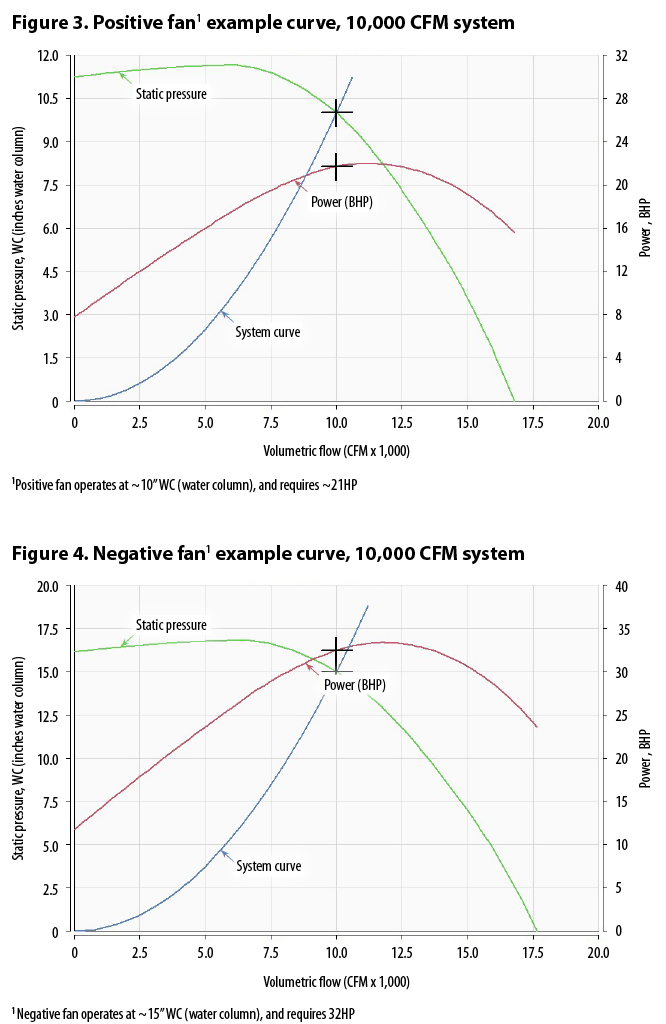
Fan Efficiency: While moving warm saturated air requires a stainless rather than mild steel to avoid corrosion, the impact on mass flow rate is small since there is minimal difference in density, as shown in the calculations below. For example, warm, high relative humidity (RH) air is only slightly less dense than cooler air at lower RH.
70°F at 50% RH => 0.074 lb/CF
120°F at 100% RH => 0.065 lb/CF
Although the fan efficiency will be slightly different between a positive versus negative application, the efficiency is very low relative to the effect of pressure. Overall, systems with negative aeration tend to require 20% to 30% more energy to move the equivalent volume of air as a positive system.
Continuous Or Duty Cycle?
Since the composting microbes will require varying rates of air over the process retention time, matching the fan output to this biological demand is recommended. This can be done through cycling the air on a duty cycle (either with a damper, or on/off control of a fan), or by modulating airflow (either using a modulating damper or fan VFD).
Two common factors help inform a facility’s decision:
- Maintaining consistent process conditions (and oxygen levels) helps the biological process. In general, continuous duty aeration or very short duty cycles, on the order of minutes rather than hours, help to maintain favorable conditions.
- Fan efficiencies tend to decrease as they approach zero flow. While modern VFD’s help minimize these system efficiency losses, fan performance tends to drop off rapidly below 20% speed. This can tend to favor duty cycles for applications that would result in a lower fan speed.
Overall, fans play a critical role in forced aeration composting. Selecting a fan configuration depends upon a project’s specific goals. Our experience shows that most applications achieve best efficiencies and project economics by using distributed fans and automated controls. However, there are some large-scale systems with very short retention times where the dedicated fan approach offers greater overall value.
Baraka Poulin is the Business Development Manager at Engineered Compost Systems.


